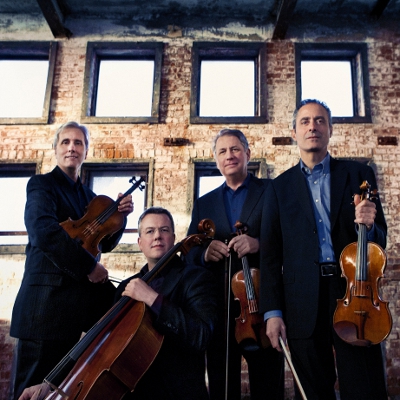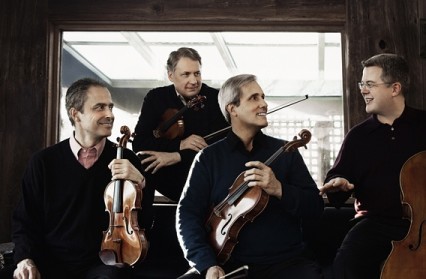Dora Stoutzker Hall, Royal Welsh College of Music and Drama, Cardiff, November 18 2015
The Emerson String Quartet: Eugene Drucker, Philip Setzer (violins), Lawrence Dutton (viola), Paul Watkins (cello)
Beethoven: String Quartet No. 16 in F, Op. 135
Bartók: String Quartet No. 4
Schubert: String Quartet No. 15 in G (D 887)
Even in a capital city as vibrant and on the move as Cardiff, a concert by the Emerson Quartet, globetrotters in a world where many think they’ve long been supreme, is an astonishing event. It’s even more astounding that this was their second appearance in less than a year. It has a lot to do with the arrival in their ranks of the Welsh cellist Paul Watkins, who is also occupant of the Jane Hodge International Chair in Cello at the Royal Welsh College of Music and Drama, where both concerts have taken place. The college’s re-birth as a thrusting conservatoire from a dormant and sometimes riven provinciality reflects the buzz of the metropolis in which it’s occurred. Punters queue for tickets to an Emerson recital everywhere and anywhere. Despite its rarity, a visit by them is these days only what Cardiff deserves. This concert was sold out early.

Watkins, from Argoed, in Gwent’s Western Valley, was the youngest ever principal cello of the BBC Symphony Orchestra before he left to join the Nash Ensemble and extend his career as soloist and conductor. He replaced the Emerson’s David Finckel in the 2013-14 season, when the long-serving cellist left to pursue other musical interests. On his departure, Finckel was regaled with an encomium from his three remaining colleagues that might have applied in a different sense to his replacement. Some of the sillier comments on Watkins’s arrival – that he had ‘re-invigorated’ the quartet – were gauche aspersions cast on Finckel’s stature as described in the remarks of his co-musicians. Watkins has simply provided continuity, though his comparative youth may well come to be seen as a boon.
The cellist is always conspicuous in chamber ensembles, such as the Emerson, whose other members stand up to play. On his cellist’s riser and centrally placed, Watkins catches the eye a nano-second before he catches the ear. Or so it appeared on this occasion, with a programme seemingly designed in parts to emphasise his elevation. The last quartets of Beethoven and Schubert framed Bartók’s extraordinary Fourth Quartet, whose third movement requires the cellist to rhapsodise over a drone-like chord before his melody is answered by the violin in a variation of the tune. It’s the cellist affirming the quartet’s half-circle structure at the summit of its arc, and Watkins did it full justice, as he did for the pleading solo that opens Schubert’s second movement. But the Emerson are greater than the sum of their four parts in the same way as the music they played, and the way they played it, seemed to suggest something bigger in scope. The Bartók, with its development of motifs, searing dissonances, ‘night music’ (complete with Janáček-type sounds of nature), folk derivations and generally expressionistic tone, is a quartet that seems always to be giving birth to a symphony; something greater, anyway, than what its constituents amount to.
In a similar way, the Schubert quartet seems to prefigure what would have been grander musical edifices, had the composer lived. Symphonic in pretension, it’s for ever echoing something deeper, especially in the way it sounds. Grist to the mill, then, for the Emerson, who at times appear to be a quartet giving birth to a string orchestra, so fierce is their energy and concentration and so alive are they to the rationale of their inner groupings and workings. Watkins told an American newspaper on his appointment that the Emerson had developed a warmer, darker and more relaxed tone, though, unlike those wishful-thinking commentators, he declined to ascribe such changes to his arrival. Their Schubert was warm and dark but thankfully not too relaxed, as it required them to be alert to its variegated character, by turns manic, elegiac, and feverish. They were all of those.
As is often their wont, the violins swapped places, Setzer leading for the Beethoven and the Haydn encore – the minuet from Op.76 No.3 – and Drucker changing places with him for the Bartók and the Schubert.
Beethoven and the Emerson are synonymous. Having many times traversed the darkening landscape of the quartets, they arrived at this lighter but sometimes fragmented valediction as the listener does: with relief – and surprise at its contrariety. They revelled in the fun of the scherzo/trio, descended inevitably into the troubled second variation of the slow movement’s theme, and helped us in the final movement to decide how the composer felt on departing the form in which he had excelled. Unrepining, we are inclined to believe. One mark of genius is that it confounds expectations.
The Emerson attract mostly superlatives, which have become clichés. To say that what they do passes understanding is at least a new one, though their having been together for a long time helps. Watkins, on this showing, has fitted in perfectly, not so much slipping into old shoes as bringing with him an unostentatious and comfortable pair of his own.
Header photo © Lisa-Marie Mazzucco



 Enjoyed this article? Support our writers directly by buying them a coffee and clicking this link.
Enjoyed this article? Support our writers directly by buying them a coffee and clicking this link.







